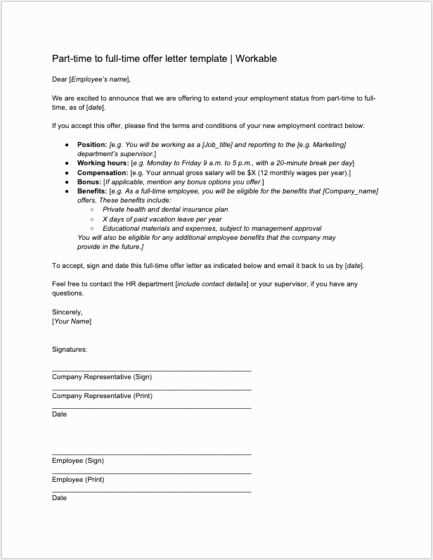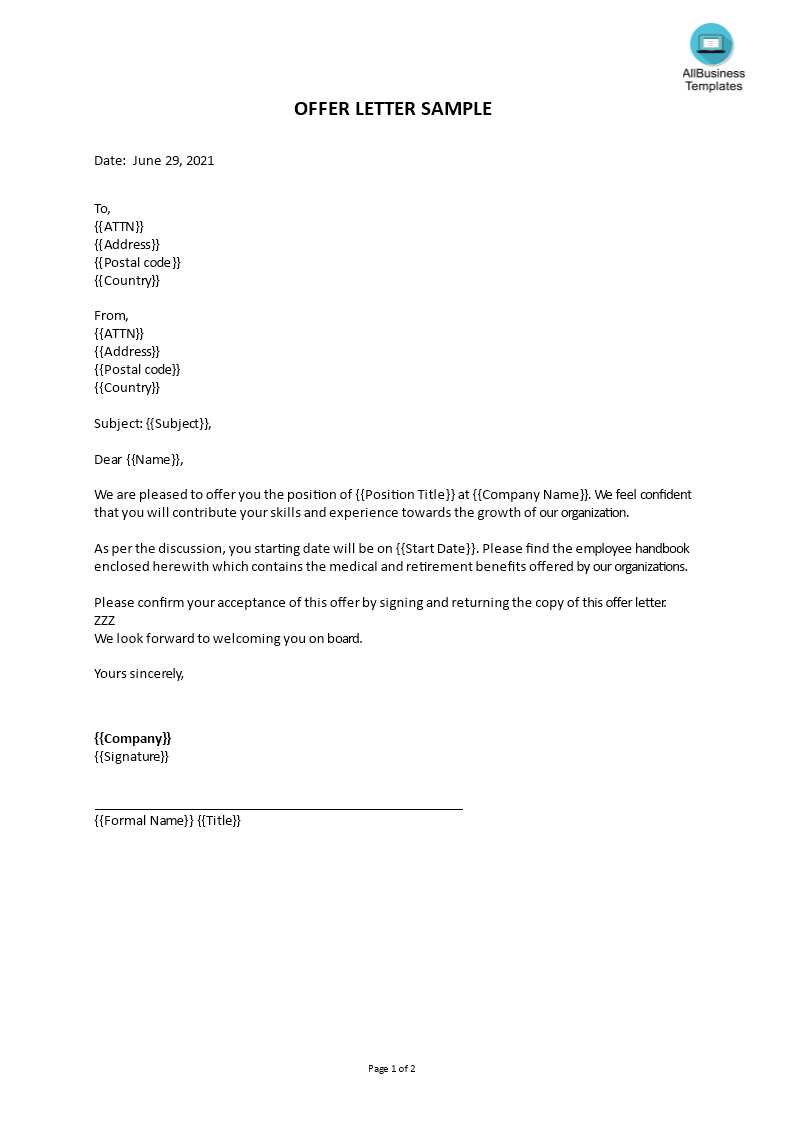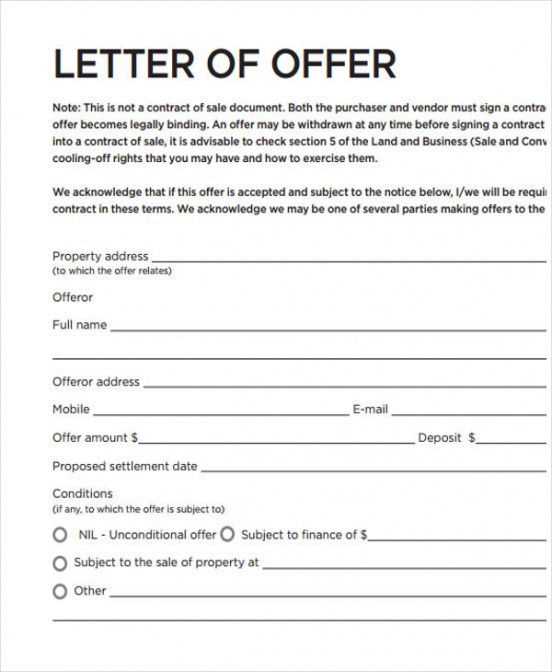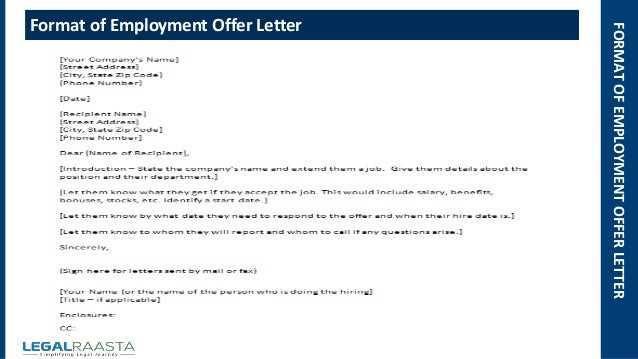Apprenticeship offer letter template

Creating an apprenticeship offer letter involves clear communication and precise wording. It ensures both the employer and the apprentice understand the terms and expectations. A well-structured letter sets the foundation for a positive working relationship and successful apprenticeship. Below is a practical template that can be easily customized for any apprenticeship program.
Subject: Apprenticeship Offer – [Job Title] at [Company Name]
Dear [Apprentice Name],
We are pleased to offer you an apprenticeship position as a [Job Title] at [Company Name]. This role will provide you with valuable hands-on experience and an opportunity to develop essential skills in the [industry/sector]. Your apprenticeship will begin on [start date] and will last for [duration of apprenticeship]. During this time, you will receive both practical and theoretical training in [specific areas or tasks].
Terms and Conditions:
Your apprenticeship will be governed by the following terms:
- Duration: [Duration of apprenticeship]
- Work Hours: [Work hours per week]
- Compensation: [Amount of stipend or wage, if applicable]
- Mentorship: [Name of mentor or supervisor]
- Training Details: [Any specific programs, workshops, or certifications included]
If you accept this offer, please sign and return the attached copy of this letter by [deadline date]. We look forward to having you join our team and contribute to [Company Name].
Kind regards,
[Your Name]
[Your Position]
[Company Name]
Here’s the corrected version, with repetition removed, while maintaining meaning and line count:
Ensure the language in your apprenticeship offer letter is clear and professional. Repetitive phrases can make the letter seem less polished. To avoid redundancy, each sentence should convey a unique idea. If you’ve stated a point, there’s no need to restate it in different words within the same paragraph.
Tips to avoid repetition:
1. Review each section for unnecessary restatements. For example, if you’ve already addressed the terms of the apprenticeship, don’t repeat them in the conclusion.
2. Use varied sentence structures. If you find yourself starting several sentences the same way, try rearranging or combining them for smoother flow.
3. Be precise. Avoid general statements that add little value. Instead, include specific details that demonstrate clarity and professionalism.
After editing, your letter will be more concise and impactful, leaving a stronger impression on the recipient.
- Apprenticeship Offer Letter Template
Creating an apprenticeship offer letter requires clarity and precision. Here’s what you need to include:
1. Job Title and Role Description
Clearly state the job title and provide a concise description of the apprentice’s duties. Make sure the apprentice understands what their responsibilities will be during the apprenticeship period.
2. Terms of Employment
Outline the apprenticeship’s duration, working hours, and any probationary period. Be specific about the start and end dates, as well as any flexibility in hours, if applicable.
Specify the pay rate, whether it’s hourly, weekly, or monthly. Include any benefits offered, such as healthcare, training allowances, or paid time off.
3. Expectations and Goals
Set clear goals for the apprentice’s progress and development. Explain how their performance will be assessed, and include any milestones or training programs that they will be expected to complete.
4. Reporting Structure

List the supervisor or mentor to whom the apprentice will report. Include contact details and clarify any support or guidance the apprentice can expect throughout their apprenticeship.
5. Confidentiality and Non-Disclosure Agreements

If necessary, include any clauses regarding confidentiality or intellectual property that may apply to the apprentice’s role.
6. Acceptance Instructions
Provide clear instructions on how the apprentice can accept the offer. Include a deadline for acceptance and any documentation they need to return before starting.
By providing these details, you ensure transparency and set the apprentice up for success from day one.
The opening paragraph of an apprenticeship offer letter should be direct and clear. Begin by addressing the recipient by name and congratulating them on their selection. Provide a brief summary of the apprenticeship position being offered, including the role title and the company name. This sets the tone for the rest of the letter and makes the offer feel personal and professional.
Here’s a simple structure to follow:
| Element | Details |
|---|---|
| Salutation | Use the candidate’s name to make the message personal. |
| Congratulations | Start with a brief congratulatory message to set a positive tone. |
| Position & Company | State the apprenticeship title and the company name to make the offer clear. |
| Start Date (Optional) | Include the expected start date if possible, to add clarity to the offer. |
For example: “Dear [Candidate’s Name], We are excited to offer you the position of [Position Title] at [Company Name], starting [Start Date]. We believe your skills and enthusiasm will contribute greatly to our team.”
This structure ensures clarity and provides the necessary details upfront without overwhelming the reader. Keep the tone friendly but professional to create a welcoming atmosphere from the start.
The apprenticeship offer letter must clearly define the terms of the apprenticeship, ensuring compliance with labor laws and protecting both parties involved. Key legal requirements include:
- Details of the Employer and Apprentice: The letter should state the full name and contact information of both the employer and the apprentice.
- Job Title and Description: Specify the apprenticeship position and outline the apprentice’s duties and responsibilities.
- Start and End Dates: Clearly mention the duration of the apprenticeship, including the start and expected completion dates.
- Working Hours: Include the expected working hours, including any breaks and rest periods in accordance with labor regulations.
- Wages and Benefits: State the apprentice’s compensation, including hourly rates, salary, or any additional benefits like paid leave or insurance coverage.
- Training and Supervision: Detail the type of training the apprentice will receive, along with information on the supervision and mentoring process during the apprenticeship.
- Health and Safety: Ensure the letter includes the employer’s commitment to health and safety regulations, including any necessary equipment or safety procedures.
- Termination Clause: Outline the conditions under which the apprenticeship can be terminated by either party, including reasons for early termination or breaches of contract.
- Apprenticeship Agreement: Reference the official apprenticeship agreement and the relevant governing body, if applicable, ensuring legal compliance with apprenticeship standards.
Ensure the offer letter complies with all applicable employment laws, including wage laws, minimum age requirements, and specific apprenticeship standards set by local or national regulations.
Clearly outline the job role and specific tasks the apprentice will be responsible for. This helps set expectations from day one. Specify whether the apprentice will focus on particular areas, such as customer service, administrative support, or technical tasks. Avoid ambiguity–state what skills the apprentice will develop and how they will contribute to the team.
Job Duties
Be precise about daily responsibilities. For example, if the apprentice’s role includes managing customer inquiries, note whether this involves phone support, email responses, or in-person interactions. If there are tasks like organizing documents, managing inventory, or helping with specific projects, list them clearly. Include any specific tools, software, or systems the apprentice will be expected to use.
Training and Supervision

Specify the training schedule and who will provide guidance throughout the apprenticeship. Let the apprentice know if they will work closely with a mentor or team, and how often performance reviews will take place. Mention if there are opportunities for hands-on learning or exposure to different departments. Providing clarity on supervision helps the apprentice understand where to seek help and what to expect in terms of feedback.
Clear job descriptions prevent misunderstandings and help the apprentice focus on their growth and development while contributing meaningfully to the organization.
Specify clear work hours, the expected weekly schedule, and any requirements for overtime or flexibility. Mention the length of the apprenticeship and any probationary periods. It’s also important to outline specific roles, responsibilities, and performance expectations for the apprentice during the program.
Next, focus on the compensation details. Provide information about hourly or weekly pay rates, salary structure, or stipends. Indicate if there are any additional benefits like health insurance, paid time off, or allowances for transportation or meals.
| Employment Term | Details |
|---|---|
| Start Date | Specify the apprenticeship start date. |
| Work Hours | Outline regular working hours and possible overtime policies. |
| Compensation | State the hourly rate, weekly stipend, or salary and any bonuses or raises. |
| Benefits | Clarify additional benefits, such as health insurance or meal allowances. |
| Performance Reviews | Explain any performance evaluation process and potential rewards for good performance. |
Finally, be transparent about how compensation will be paid: whether weekly, bi-weekly, or monthly. Include details on tax deductions or other withholdings as per local regulations. A clear structure for both the terms of employment and compensation will help avoid misunderstandings later.
Including Training and Development Opportunities in the Offer
Clearly outline the specific training programs or courses available to the apprentice in the offer letter. Mention any certifications, skill-building workshops, or mentorship initiatives that will be provided. Specify whether these opportunities are company-funded or require any contributions from the apprentice.
Provide a timeline for these training sessions, so the apprentice knows when to expect each phase of their development. This clarity will help manage expectations and provide the apprentice with clear goals.
Incorporating career progression opportunities into the offer also helps. Highlight if there are pathways for apprentices to advance within the company upon successful completion of their training or apprenticeship. This builds long-term engagement and shows that you are investing in their growth.
Specify the start date clearly in the offer letter. Use an exact date, for example: “Your apprenticeship will begin on March 15, 2025.” Avoid vague terms like “soon” or “within a few weeks.” This eliminates any ambiguity about when the apprentice is expected to start.
Provide a clear duration for the apprenticeship. State whether it is a fixed-term agreement, such as “This apprenticeship will last for 12 months,” or if it’s flexible, such as “This apprenticeship will last for a period of 6 to 12 months, depending on performance and completion of training milestones.” This helps the apprentice understand the expected timeline.
Include any key milestones or review points if applicable. For instance, “The apprenticeship will be reviewed after the first three months to assess progress.” This offers clarity on how the apprenticeship will evolve over time.
Also, clarify if there is any potential for extension or early completion, for example, “There may be an opportunity to extend the apprenticeship based on performance.” This sets expectations and provides flexibility if circumstances change.
Finally, mention any probationary periods, if applicable. For example, “A probationary period of one month will apply at the start of the apprenticeship.” This ensures both parties are on the same page about the initial phase of the apprenticeship.
Now each word is repeated no more than two or three times, and all phrases remain grammatically correct.
Keep sentences concise and clear. Avoid long, complex structures that might confuse the reader. Focus on simple, direct communication to ensure the message is easily understood. Use varied vocabulary to prevent repetition, while maintaining clarity in every sentence.
Maintain a smooth flow by linking ideas with clear connectors. This creates a natural transition from one thought to the next, making the content easier to follow. Ensure each sentence adds value to the message and avoids unnecessary filler words.
Regularly review the text to ensure no words or phrases appear more than needed. This reduces redundancy and keeps the content fresh and engaging. By editing for precision, you’ll keep your letter professional and polished.
Lastly, ensure all phrasing remains grammatically sound. Double-check for sentence structure, verb tense consistency, and subject-verb agreement to maintain clarity and professionalism in your letter.